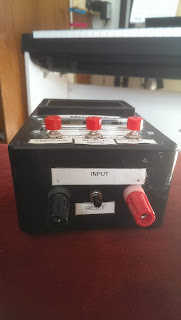Date of completion: 2019
This refers to a couple of devices (a "transmitter" and a "receiver") designed and built to facilitate communication between a church leader and an organist. These people are often situated far apart in church services, and the organist needs to be kept up to date about when to start/stop/prepare for playing. This is certainly true in Seal church, Kent, where my wife is the vicar and I sometimes attempt to play the organ!
Photos
Design
Both devices are designed around the CC1101 transceiver, which is a rather sophisticated device from Texas Instruments, but which is very cheap via Ebay. It comes with lengthy instructions and a software program to help with choosing set-up parameters. The devices also each have a PIC microprocessor. I used two quite different PICs (PIC16F1503 and PIC18F2550), as I just happened to have them available, but there are only slight differences in programming details. They are programmed very similarly using C (XC8 from Microchip, who make the PICs), although one is primarily the transmitter and the other is primarily the receiver. They respond correctly to button presses only if there is a two-way communication between them, however.
Each has an on-off switch to preserve battery life, but they are also programmed to enter standby mode after 90 minutes of inactivity. Each has a white light to indicate that it is switched on and is consuming power. I have minimized power consumption by putting the CC1101s either into SLEEP mode or WAKE-ON-RADIO mode (testing for a received signal every 1 second) between transmissions and using the SLEEP mode of the PICs whenever there is activity (waking on interrupts (a) from the CC1101, (b) from a button being pressed, or (c) from the watchdog timer to keep the white light flashing.)
When a transmitter button (red, yellow or green) is pressed a signal is sent to the receiver, which flashes the appropriate LED once and sends back a signal to the transmitter. When this signal is received the transmitter flashes its own appropriate LED once. If the original button is held down, the process repeats until the button is released. There is a HELP button on the receiver, so that the organist can attract initiate communication, if needed. When pressed the red and green LEDs on both devices flash continuously until either the HELP button is pressed again or one of the buttons on the transmitter is pressed.
When first switched on both devices flash all three coloured LEDs once. Error-trapping is enabled by resetting the CC1101 and PIC (and therefore flashing all three coloured LEDs once again) if trying to communicate when, for example, only one of the two devices is switched on. Each is powered by two AA batteries, which should last for several years before needing to be replaced (if my calculations and measurements are correct, and there are no serious bugs in the programs!)
Circuit Diagrams
Source code and other files



















